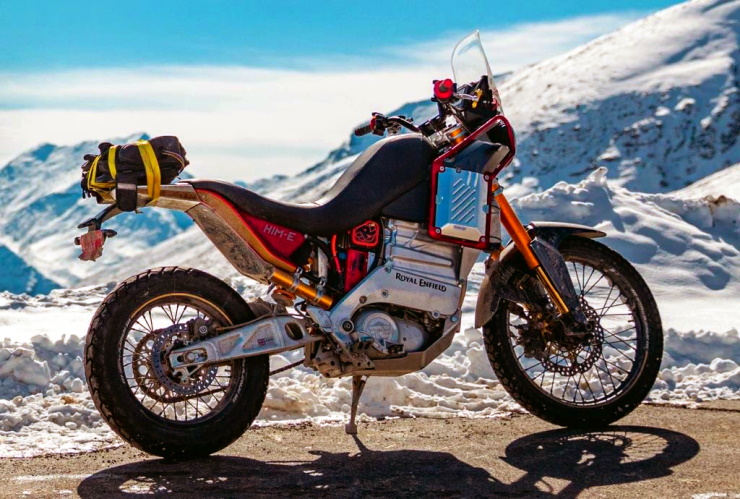

Royal Enfield’s electric Himalayan, internally dubbed Him-E, has been seen undergoing high-altitude testing in Ladakh. These units look refined—much closer to what we’d expect from a showroom-ready model.
Premium suspension: Upside-down front forks and Ohlins (or similar high-spec) rear shocks indicate serious off-road capability.
Wheels & tyres: Spoked alloy wheels (possibly SM Pro Platinum billets) wrapped with off-road Bridgestone Battlax tyres—built for rugged terrain.
Brakes: Nissin calipers paired with petal discs point to reliable stopping power.
Dashboard: Rally-style 7-inch ECUMASTER instrument cluster elevates its tech appeal.
Frame & Powertrain: The battery and motor appear to act as stressed structural elements, using an aluminum frame design for durability and rigidity.
Design cues: It retains the classic Himalayan silhouette with round LED headlamp, single-piece seat, windscreen, and upright ergonomics familiar to the brand’s popular adventure bikes.

Battery & power: Reports suggest a 14 kWh battery pack powering a motor capable of delivering around 100 hp (roughly 74.5 kW), making it potentially the most powerful Royal Enfield ever made.
Range: Expected riding range is estimated between 200–250 km on a single charge.
Launch speculation: Industry insiders anticipate a formal showcase—possibly at EICMA 2025—with a market launch between late 2025 and 2026.
Event strategy: Royal Enfield has already been field-testing multiple units with both national and international riders to collect feedback—indicating serious intent to go global with this model.
Positioning: This E-Himalayan appears to be aimed as a premium offering, likely coming with a price tag in the ₹7–8 lakh (ex-showroom) range—making it among the most expensive Royal Enfields if launched in this form.
Context: Meanwhile, Royal Enfield’s first mainstream electric bike, the Flying Flea C6, is slated to debut earlier—in early 2026—as a more accessible urban model

Going into details, the Him-E appears to be in its near-production guise, however, there are still a few unfinished touches here and there. The side panel sports a ‘test bed’ sticker, which means that it is still a test prototype. Upfront, a new LED headlamp, tall windscreen, LED turn indicators, and a black side panel with the silver outline are the highlights of the electric Himalayan.
It gets a long single-piece seat which extends all the way till the tank area with the prominent Royal Enfield branding. We can also spot a small luggage rack at the rear. Apart from this, the electric ADV features golden-spoke wheels fitted with dual-purpose block-pattern tyres, a beefy aluminium swing arm, and a clean rear profile where the LED indicators double as tail lamps. The battery pack is positioned in the engine area with a proper bash plate. There seem to be two separate battery packs powering the E-Himalayan. The electric motor can be seen on the right side of the motorcycle, surrounded by an exposed section of the main frame. The drive chain is on the left side.
| Aspect | Highlights |
|---|---|
| Prototype maturity | Near-production form spotted, refined design and build |
| Key features | Premium suspension, rally-style dash, aluminum frame using battery/motor as structural components |
| Performance | ~14 kWh battery, ~100 hp output, ~200–250 km range |
| Launch timeline | Expected reveal at EICMA 2025, possible launch by 2026 |
| Market positioning | High-end electric adventure bike, priced premium |
| Complementary model | Flying Flea C6 to cater to urban riders earlier (2026) |
In short, the Royal Enfield E-Himalayan is shaping up to be a serious electric adventure contender with a global ambition. Fasten your seatbelt—if things go as projected, we might see it hitting the roads very soon.

Comments